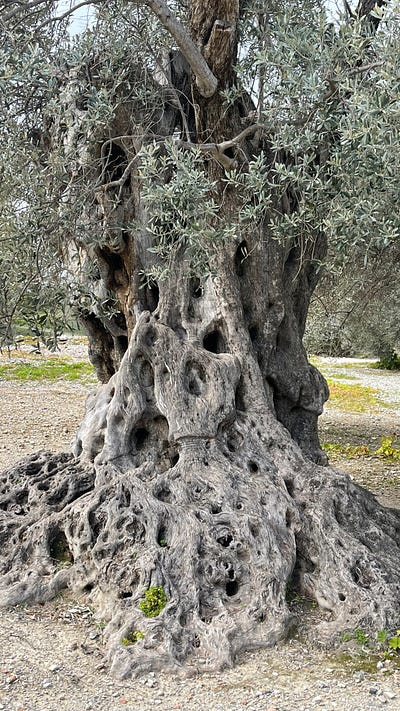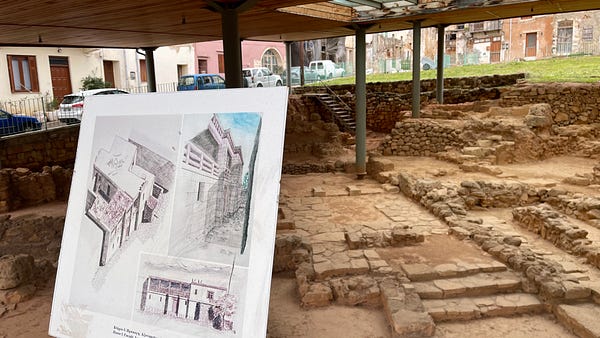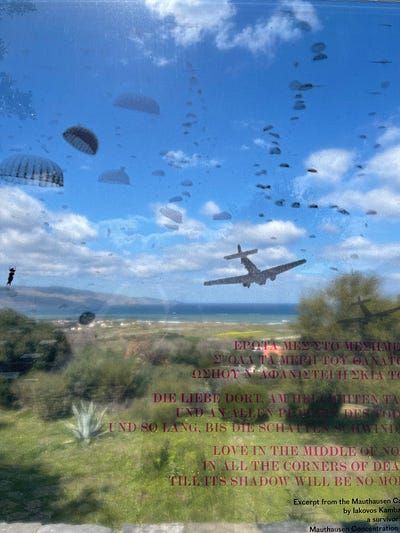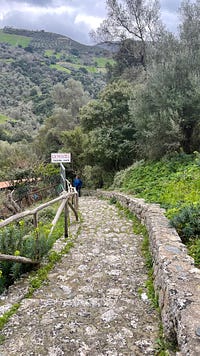Week 80 - Crete part 2
Cruising around Crete… in an RV! As we wait on Spring to start cruising the Mediterranean on our boat Matilda.

Cruising around Crete… in an RV! As we wait on Spring to start cruising the Mediterranean on our boat Matilda.
They paved paradise and put up a parking lot
With a pink hotel, a boutique, and a swinging hot spot
Don’t it always seem to go
That you don’t know what you got ’til it’s gone
They paved paradise and put up a parking lot
—Big Yellow Taxi, Joni Mitchell
We continued our way around Crete this week, from the far Eastern edge, down along the Southern coast, back through the centre and heading West along the Northern edge to where we are as I write this, in the South Western corner at Elafonissi Beach.


Rather than a blow by blow account of everything we’ve seen along the way, I’ll give some overall impressions and pull out some highlights that were interesting. The South-Eastern coast of Crete is dramatic, rugged landscapes that’s very rural and different from the Northern side. There’s very little tourist activity and what tourist hotels there are, are limited to the towns with a direct road from the North. Historically there was less going on here too, with most of the ancient civilisations focussed to the North and Western half of Crete.




The first major ruin we encountered along the Southern part of Crete was Gortyna. While the organised site was quite small, the ruins of Gortyna were extensive. It had close ties with Egypt and the Ptolemy’s (the Greek Pharaos) and at one stage rules all of Crete. It’s famous for its inscriptions which codified the city’s laws. Nowadays it’s a very underdeveloped site that has been barely excavated, with parts of temples, walls and other general ruins scattered throughout the surrounding Olive Groves.

Next was the Minoan Palace of Phaistos, which was where the Phaistos Disc was discovered. Still undeciphered, the Phaistos Disc is remarkable as it’s proof that “moveable type” or “printing” existed far before the Gutenberg Press. Like so many inventions by ancient civilisations, either the method, the means or the motivation disappeared only to be “rediscovered” later.


The Palace of Phaistos was a really interesting site, with a lot of walls reconstructed that gave a good sense of how it was laid out and what it might have felt like to live there. It also had spectacular views over the Olive Groves in three directions.



From there, the evening was spent at Matala. If Joni Mitchell was to return to the caves she spent several weeks living in during the summer of ’69, she’d find a very different place. The hippies have long been ejected (in the early 70’s) from the Neolithic Caves they inhabited overlooking a beach and a small sleepy fishing village. Now, the caves overlook a gigantic concrete car park and endless crappy tourist shops, restaurants, pirate themed bars and other tat that really ruins the feel of the place. In a word, it’s “tacky”. It is however still full of hippies, who, at least during the off-season, are living in the camp grounds in various dilapidated old camper vans. We stayed a night as well, like most things during February here — nothing was open. The campground office was closed, but we just found a spot and stayed with the gentle strumming of guitar from the hippies next door keeping us company into the evening.


After discovering all the rugged coastlines and remote areas along southern Crete, it was time for some civilisation and we headed into Rethymno. This is a very cute old Venetian and Ottoman influenced town with a large central area restricted to traffic. Most things were closed but we were fortunate to find a restaurant which had literally just opened that day, ready for the “official start” to the tourist season which is March1st. It was cold, windy and wet the whole time we were there and we ended up having to relocate the van because the wind was buffeting us so severely we couldn’t sleep! I think of the cities we’ve seen in Crete so far, Rethymno is my favourite.


Then it was on to Chania, another old Venetian town, although with a different feel to it. Although the street “foot prints” are still the same, a lot of the buildings and construction are more modern because it was all largely destroyed during fighting in the second world war.
Not all days are good days and I’d have to say this was one of our worst. The weather was miserable, everything was closed and when we got back to the van, we saw a group of four boys hanging around. There were a couple of people walking along the street in front of us, and the boys just gave us the impression they were waiting for us all to pass. When we stopped and opened the door to the van, they immediately started walking away — when I got inside, one of the windows had been levered open, breaking the locks and cracking the plastic. Clearly they’d been trying to break in, heard people coming and stepped back to wait — we’d fortunately disturbed them before they could do any more than damage a window.
Whenever something like this happens it really shakes your sense of safety and I haven’t felt comfortable leaving the van unattended since, although we’ve also only seen groups of boys like this in Chania, not anywhere else.
And yet things turn that put it all into perspective and make these troubles seem very small and unimportant.

One of the unexpected places we visited was a German War Cemetery. There’s a lot of history here from World War II, Crete has always been a strategically important place and has spent a lot of its history under some form of occupation. World War II was no exception and after the allies retreated to Crete from the defeat of Greece, the Germans decided to invade as it provided a strategic place to base aircraft in this part of the Mediterranean and was also an important stop on the supply route to Northern Africa.
The cemetery holds the remains of around 4,800 Germans, the majority of whom died during the invasion. Walking through and seeing the average age at around 19–20 years of age was a sobering experience, especially as Russia had just started its invasion of Ukraine. It’s a stark reminder of both the pointlessness but also the humanitarian cost of war. The cemetery was built with the aid of the Cretan Partisans who fought the Germans and does nothing to glorify the conflict, its goal is to educate people on the human cost and they sponsor tours for German youth to visit and learn about this part of history, including the war crimes committed.
We’ve met Ukrainians on our travels and other Eastern Europeans like our friend Erik from Lithuania. The conflict feels a little more real when you have a connection, however small, to people that are suffering. We met Olia (https://www.instagram.com/olia_pysarenko/) in Ermioni around September last year and enjoyed a great chat with her and her enthusiastic friend who wanted to make a video tour of Matilda. We’ve followed each other on instagram since and its sobering to see her feed change from literally last week holidaying in Lithuania and commenting on what she’s seen to now sheltering in bomb shelters and fear for what’s happening. I hope she stays safe and well and wonder what’s happened to her friend who would be the right age to be fighting now.
Everyone has their own perspective on how this impacts them as well — with energy prices already “out of control” in Europe, it seems this will cause even more turmoil and the Greeks who are heavily reliant on tourism are just shaking their heads. Two years of Covid and now this threatens to shut down their number one tourist market. They will of course bear it, there’s strong support here for Ukraine as in the rest of Europe.



On a more positive note, we ended the week in Elafonissi Beach. I think this is the most stunning beach we’ve found on Crete and probably therefore one of the most stunning beaches in Greece. We’re a little jaded about beaches to be honest — without bragging too much, coming from Australia, even the best beaches here leave us a bit “meh”. How do you compete with beaches that are literally 70 kms long of untouched, pure white sand? But Elafonissi is lovely and at this time of year, on the cusp of season starting still attracting a few other tourists like us in their camper vans.


May all our friends, in all parts of the world stay safe and well, but especially those we’ve met from Ukraine 🇺🇦.
Until next time,
Tim & Karina
